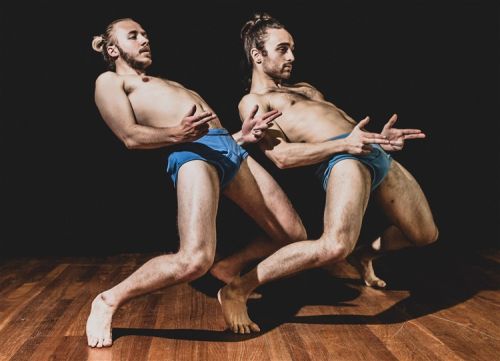
This triple bill of Resolution! 2014 had a theme of exposure and sexuality running through it, some of which hit the mark and some of which didn’t.
Opening the night was Slanjayvah Danza’s Minor Tears, which saw two dancers, clad in flesh-coloured underwear, powering their way across the stage through highly physical choreography. Almost every inch of their bodies was on display; there was no excess clothing to hide the complex physiological systems that were working hard to get them through the demanding movement (executed impressively by both performers). Multicoloured sports tape on their bodies highlighted specific muscles and tissues, which added an interesting visual element, and was a pertinent reminder of our bodies’ complexities – sometimes I forget the beautiful way in which fascia lines twist and spiral around legs and torsos.
Minor Tears exposes the athleticism and physical demands faced by professional dancers whilst also reminding us of the vulnerabilities of their bodies. But this could have been achieved solely through the choreography and the tell-tale presence of the tape; thanks to its visibility in professional sports, the use of sports tape in connection with weak spots or recovering injuries is not an unknown fact. As it was, the ending, which featured an overly literal spin on suffering an injury and a PowerPoint-style information slide, was perhaps uneccessary. It left the work feeling overly didactic, more suited to an educational lecture demonstration than an artistic work.
Holasz’s Why fronts: A contemporary lap dance opens with Georges Hann in a shirt and blue briefs escorting selected audience members to sit in the empty chairs on stage (they even got a name tag). A duet begins between Hann and musician Tad Sargent, Hann’s legs quivering, hips swinging and twisting while Sargent responds to his movement on a drum. The dynamic between these two is fun to watch.
Hann is eventually joined by second lap dancer Charlie Ford. Together they make an entertaining duo, exploring a mash up of moves with and without the sex factor, now and again shooting off sultry looks and finger pistols. Add in a Ukrainian folk song interlude, and you'll have a pretty good idea of the elements at play. Why Fronts felt like it pandered to the crowd, riding on the easy laughs that two men grinding around the stage will inevitably get. Some moments amused, but many seemed trite, and I wonder about the alcohol at the end (I know it’s a party, but does alcohol always have to be paired with sex?) and whether it was entirely necessary to put the on-stage audience members through several blush-inducing experiences.
Sex trafficking is a horrific issue extremely worthy of attention, however, LCP Dance Theatre’s exploration of this human rights concern in Am I missed the mark. Some moments made an impression, such as the more theatrical vignettes at the start of the work. Here, the lighting was bold (switching from green, to red, to blue) but served its purpose, eerily highlighting different individuals. However, for the most part, the recourse to commonplace contemporary dance vocabulary was ineffectual in conveying the appalling nature of human trafficking, and edged the work away from a condemnation of sexual exploitation and towards gratuitous sexualisation. One solo that was more classical than other parts, with high legs, pointed feet, and graceful arms, seemed especially out of place. While I appreciate LCP Dance Theatre’s highlighting of this important issue, ultimately the movement was too stylised and superficial to speak to a reality that is thoroughly violent, visceral and violating.
